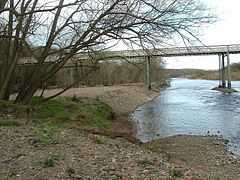Ovingham Bridge
| Ovingham Bridge | |
|---|---|
 Ovingham Bridge | |
| Coordinates | 54°58′01″N 1°52′01″W / 54.967°N 1.867°WCoordinates: 54°58′01″N 1°52′01″W / 54.967°N 1.867°W |
| OS grid reference | |
| Carries | Single road with central passing place |
| Crosses | River Tyne |
| Locale | Northumberland, England |
| Characteristics | |
| Design | Lattice Beam supported by steel piers |
| Total length | 150 m (490 ft) |
| Number of spans | 8 equal (2 over water) |
| History | |
| Constructed by | Dorman Long, Middlesbrough |
| Construction begin | 1883 |
| Construction end | 1883 |
| Opened | 20 December 1883 |
| Replaces | Ferry |
| Statistics | |
| Daily traffic | 5,000 cars per day[1] |
| Toll | No |
 Ovingham Bridge Location in Northumberland | |
Ovingham Bridge is a bridge across the River Tyne at Ovingham, Northumberland, England.
The bridge is a single track of reduced width for cars and light vans only. There is no footpath; pedestrians use the separate footbridge that runs alongside and with the same deck level. The center piers are set wider, allowing the deck to spread and two vehicles can pass, although this is rare. No traffic controls are installed; drivers observe the far end and wait or enter the bridge using a set of unwritten rules that usually function well.
History
It was built in 1883 by the Ovingham Bridge Company and replaced the earlier ferry.[2] The steel tubes are marked Dorman Long Middlesbrough, the firm that designed and built the Sydney Harbour Bridge and the Tyne Bridge. It was originally opened and operated as a toll bridge until 1945.[3]
The toll house has long since been demolished. It was located on the down stream side at the southern end of the bridge.[4] In 1974 a footbridge was erected alongside, immediately downstream of the main bridge.
In 2009 both bridges underwent a strengthening programme as they had been closed during the January floods of 2005. Gabions have been installed around the base of the pilings to prevent scour and river channel has been dredged to direct the main flow away from the piers. As the original piling depths are not recorded, brackets have been welded to the pilings and seismic pulse testing performed.
On June 30, 2014 the vehicle bridge was closed for extensive maintenance projected to take around 12 months. A small closing ceremony saw the last vehicle to cross - a horse and cart - as a reminder of the first vehicle to cross when it was originally opened. During May and June 2014, access trackways were built to the underside of both ends of the bridges, and extensive steel scaffolding installed below and to both sides of the bridge structure. The scaffolds even incorporate wooden boarded cutwaters to protect the scaffold if the river should flood. Lattice long span 'unit beams' are fitted to all spans except the North and South. Concrete pads have been cast below the bridge end spans adjacent to the approach roads for so the spans can be jacked up. Presumably this is to access or modify the area where the steel bridge rests on the stone abutment. The bridge deck including cross beams are due to be completely replaced. The footbridge will also be closed and have new decking. Pedestrians will use the main bridge whilst this is underway.[5]
References
- ↑ http://www.hexhamcourant.co.uk/news/2.2978/will-our-historic-bridges-be-able-to-stand-test-of-time-1.1026178
- ↑ Fraser, Constance; Kenneth Emsley (1989). Northumbria. Chichester, Sussex, England: Phillimore & Co. Ltd. ISBN 0-85033-723-2.
- ↑ "Ovingham Bridge". Bridges on the Tyne. Retrieved 2009-03-29.
- ↑ Atkinson, Frank. The Story of Ovingham on Tyne. pp. Picture 97. ISBN 0-9535730-1-X.
- ↑ "Ovingham Bridge to close for 12 months for refurbishment". 5 June 2014.
External links
| Next bridge upstream | River Tyne | Next bridge downstream |
| Bywell Bridge | Ovingham Bridges Grid reference: NZ086636 |
Wylam Railway Bridge (disused rail, now foot and bicycle) |
| Next road crossing upstream | River Tyne | Next road crossing downstream |
| Bywell Bridge | Ovingham Bridge Grid reference: NZ086636 |
Wylam Bridge |